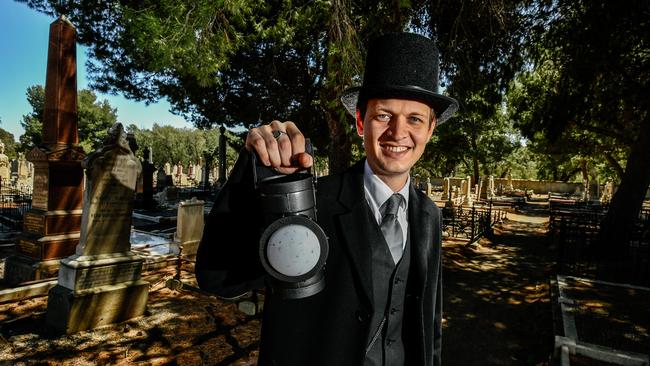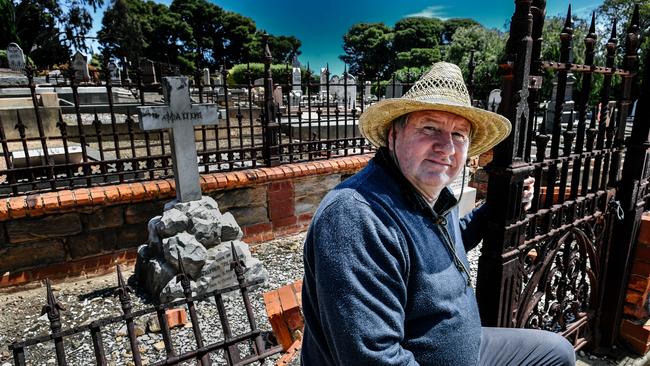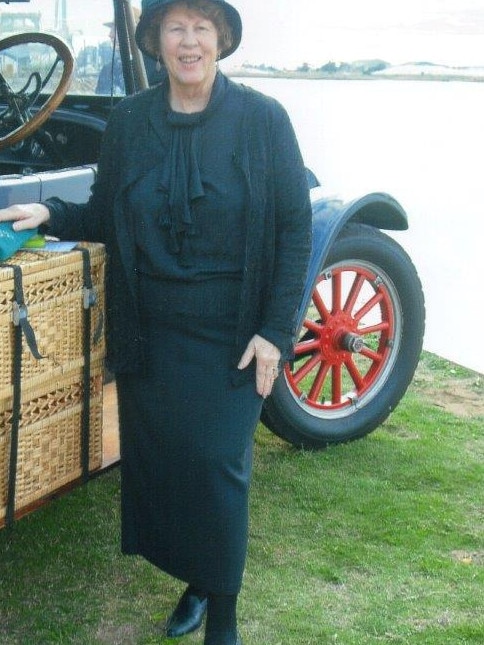Inside Adelaide’s spooky cemeteries
ON HALLOWEEN Eve, we speak to four of the people who look after our beautiful, yet spooky, cemeteries about their macabre histories.
ON HALLOWEEN Eve, we speak to four of the people who look after our beautiful, yet spooky, cemeteries about their macabre histories.
Jacob Douris
Enfield Memorial Park concierge and West Tce Cemetery Night Tours host

You could say that I have a foot in two quite different camps.
By day, I work as concierge for Adelaide Cemeteries Authority’s Enfield Memorial Park cemetery and, as darkness falls, I host night tours at West Terrace Cemetery.
While my concierge duties at Enfield Memorial Park focus on help for the living, stepping into West Terrace Cemetery, I enter a world that is home to over 150,000 resting souls.
But is it really about the dead?
You could see it that way, but I think that more than anything it is about the stories behind them.
On West Terrace Cemetery’s night tour you will come across mistresses and murderers, mavericks and madmen.
It is a shadowy place that really awakens your senses and brings your imagination alive. Guided only by the gentle light of your lantern and voices calling from the darkness, guests weave between silent monuments and come face-to-face with characters from all walks of society.
One of my favourite stories is that of Bert Edwards.
Born in 1888, Bert was a larger than life man businessman, entrepreneur and ‘The King of the West End’.
He was kind man, known to pay rent for widows and take Christmas hampers to the poor, but his life as not without controversy.
He found himself in the limelight for the wrong reasons on a number of occasions, getting up to things behind closed doors that caused social outrage in his day.
On the night tour, Bert is as brash and in your face as he ever was in life, and not one to be silenced by any marble monument, no matter how grand.
At the completion of each tour, guests often share their own stories about what they have seen. or what they thought they saw.
This is a place rich in stories.
If you’d care to step into the cemetery after dark, I am waiting to welcome you.
Mark Winders
Mitcham General Cemetery co-ordinator

THE Mitcham General Cemetery is the final resting place for some of Mitcham’s and South Australia’s early pioneers, heroes and identities.
Many of them died either in service of their country or in everyday life, and here are just some of those people.
Brothers Archibald, Raymond and Wesley Choat all fought together at the same World War I battle in 1916.
Both Archibald and Raymond were killed and buried in a French military cemetery.
Wesley was captured and spent 17 months as a prisoner of war, before escaping and arriving back to Australia in 1918.
On his return he wrote a diary of his imprisonment and was awarded the Military Medal. Wesley died in 1976, aged 81.
Fireman John A.H. Gardner was killed fighting the great R.C. Castle and Coy fire in Rundle St on Christmas Eve 1886.
His monument was erected by the citizens of Adelaide in tribute of his heroic conduct.
His large funeral procession extended for nearly half a mile from fire headquarters in Flinders St to the cemetery.
Airline passenger Vaughan Pate was killed on board a DC2 plane, the Kyeema, on October 25, 1938.
When it was on route from Adelaide to Melbourne the plane crashed into the Dandenong Ranges, killing all 18 on board.
It was the worst pre-war airline disaster in the country and led to an inquiry that resulted in a complete revamp of Australia’s aviation rules and regulations.
Wendy Takos
Port Adelaide Historical Society honorary historian

THE first burial grounds outside the city of Adelaide developed in a quite haphazard manner, and reflected the difficulties experienced by the first colonists in coping with their new environment.
At first, simple expedients had to be adopted, and the dead were buried in any convenient spot.
The first burials took place around 1837 in the heritage listed West Terrace Cemetery.
The city folk complained over the years of the smells from the cemetery and it was not surprising as some burials were not deep enough and after heavy rains were washed to the surface.
In other parts foxes and wild pigs were known to roam freely searching for bones.
From the above macabre story, I move on to the old Alberton Cemetery and this burial ground was established on the first available dry ground next to the Port.
On two sides of the four acres used for burials was salt swamp, as was land to the north.
An article written by Mr. A.T. Saunders appeared in the Register, on April 6, 1924, describes the old cemetery as “a wilderness of prickly pear”.
The first burial was October 28, 1846, Thomas Cleveland, 40, Bosun of the Canton, and he drowned while drunk.
Many of the early burials listed were of a similar state and one can only imagine the state of the bodies after being reclaimed from the sea after several days.
The cemetery was closed in 1874 with pre-existing rights reserved.
Two years later the Cheltenham Cemetery opened.
Kelly Dyer
Onkaparinga Council history officer

MORPHETT Vale Scotch Cemetery has its foundations with the early Scottish settlers who set about building a church for all forms of Presbyterianism worship.
The cemetery is on the site of what was St Andrew’s Church, but that was destroyed by fire in 1858.
Now, all that remains is the cemetery.
Several of the Scotch Cemetery inhabitants met with tragic ends.
On returning home from a dinner at the Emu Hotel to celebrate his election to the local council that very day, William Bagshaw was thrown from his cart.
He suffered serious injuries that he died from a few days later.
His widow was left with 10 children and sold their farm to Lambert Christie, after whom the area was later named.
Hackham grocer and hawker William Stillwell was struck by a train at a crossing while driving his cart from Adelaide, and died a short time later.
However, the most scandalous tale is the case of Dr Morier.
He came to South Australia in 1878 with his new bride, Susan, to become the local doctor.
There were significant personal troubles due to the transgressions of his wife.
It all became public in a colourful and lengthy court case in which Susan was accused of drunken violence towards Dr Morier and their son, who had to be removed from her care.
She was also known to be committing adultery with several men, including another doctor.
Divorce was granted on the strong evidence against her.
The doctor died a short time later at only 40 years old.


